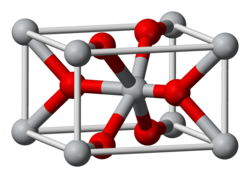Titanium dioxide, also known as titanium(IV) oxide or titania , is the naturally occurring oxide of titanium, chemical formula TiO
2. When used as a pigment, it is called titanium white, Pigment White 6 (PW6), or CI 77891. Generally, it is made from ilmenite, rutile, and anatase. It has a lot of uses, including paint, sunscreen, and food coloring. When used as a food coloring, it has E number E171. 9 million tonnes of it were made in the world in 2014.[3][4] It is used in around two-thirds of all pigments, and pigments based on the oxide have a total value of around $13.2 billion.[5]
Quick facts Names, Identifiers ...
Titanium dioxide
 |
 |
| Names |
| IUPAC names
Titanium dioxide
Titanium(IV) oxide |
| Other names
|
| Identifiers |
|
|
3D model (JSmol) |
|
| ChEBI |
|
| ChEMBL |
|
| ChemSpider |
|
| ECHA InfoCard |
100.033.327 |
| E number |
E171 (colours) |
| KEGG |
|
|
|
| RTECS number |
|
| UNII |
|
|
|
|
|
| Properties |
|
TiO
2 |
| Molar mass |
79.866 g/mol |
| Appearance |
White solid |
| Odor |
Odorless |
| Density |
- 4.23 g/cm3 (rutile)
- 3.78 g/cm3 (anatase)
|
| Melting point |
1,843 °C (3,349 °F; 2,116 K) |
| Boiling point |
2,972 °C (5,382 °F; 3,245 K) |
|
Insoluble |
| Band gap |
3.05 eV (rutile)[1] |
|
+5.9·10−6 cm3/mol |
|
- 2.488 (anatase)
- 2.583 (brookite)
- 2.609 (rutile)
|
| Thermochemistry |
Std enthalpy of
formation ΔfHo298 |
−945 kJ·mol−1[2] |
Standard molar
entropy So298 |
50 J·mol−1·K−1[2] |
| Hazards |
| EU classification |
Not listed |
| NFPA 704 |
|
| Flash point |
not flammable |
U.S. Permissible
exposure limit (PEL) |
TWA 15 mg/m3 |
| Related compounds |
| Other cations |
{{{value}}} |
| Related {{{label}}} |
{{{value}}} |
| Related compounds |
{{{value}}} |
Except where otherwise noted, data are given for materials in their standard state (at 25 °C [77 °F], 100 kPa). |
| Y verify (what is YN ?) |
| Infobox references |
|
|
Close



